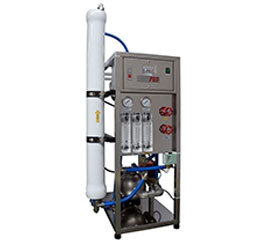




Ultra filtration or Microfiltration is a separation process using hollow fiber membranes/tubular/spiral wound or plate frame membranes, the membranes material could be PVDF; Polysulfone or Ceramics;UF and microfiltration works at low pressure (30-50 psi) to separate suspended solids and colloidal matter in liquids.
These processes are a very fine filtration that goes from 0.01 microns to 1 micron, being UF the finest filtration out of these two types.
The liquid crossflows the membrane surface at high speeds, it can also work in a dead end mode. The crossflow characteristic makes the difference between microfiltration and conventional filtration. In conventional filtration the flow is perpendicular to the filter's surface, forming a cake in the filter's surface, which accounts for frequent rinses and replacements. Crossflow prevents the formation of the cake, thus, producing high filtration levels that remain constant.
The UF/MF technology offers enormous advantages against common clarifloculation and filtration, with UF/MF the use of chemicals are practically not needed for the removal purposes and guarantees the Silt Density Levels that RO(Reverse Osmosis) membranes demands for a stable and economical operation, even in feed water characteristics fluctuations. (SDI level reached by UF for secondary effluent recycle are 2 and NTU 0.1).
What is Aquapro Ultrafiltration:-
UF Ultrafiltration is a separation process using membranes with pore sizes in the range of 0.1 to 0.001 micron. Typically, ultrafiltration will remove high molecular-weight substances, colloidal materials, and organic and inorganic polymeric molecules. Low molecular-weight organics and ions such as sodium, calcium, magnesium chloride, and sulfate are not removed. Because only high-molecular weight species are removed, the osmotic pressure differential across the membrane surface is negligible. Low applied pressures are therefore sufficient to achieve high flux rates from an ultrafiltration membrane. Flux of a membrane is defined as the amount of permeate produced per unit area of membrane surface per unit time. Generally flux is expressed as gallons per square foot per day (GFD) or as cubic meters per square meters per day. Ultrafiltration membranes can have extremely high fluxes but in most practical applications the flux varies between 50 and 200 GFD at an operating pressure of about 50 psig in contrast, reverse osmosis membranes only produce between 10 to 30 GFD at 200 to 400 psig.